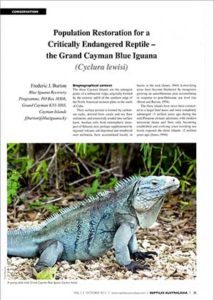
Population Restoration for a Critically Endangered Reptile the Grand Cayman Blue Iguana
The three Cayman Islands are the emergent peaks of a submarine ridge, originally formed by the tectonic uplift of the southern edge of the North American tectonic plate, to the south of Cuba.
Their surface terrain is formed by carbonate rocks, derived from corals and sea floor sediments, and extensively eroded into surface karst. Aeolian soils from stratospheric transport of Saharan dust, perhaps supplements by regional volcanic ash deposited and weathered over millennia, have accumulated locally in basins in the rock (Jones 1994). Lower-lying areas have become blanketed by mangroves growing on autochthonous peat accumulating in response to post-Holocene sea level rise (Brunt and Burton, 1994).
The three islands have never been connected to a larger land mass, and were completely submerged ~3 million years ago during the mid-Pliocene climate optimum, with modern terrestrial fauna and flora only becoming established and evolving since receding sea levels exposed the three islands ~2 million years ago (Jones, 1994).


 Member: IUCN, Species Survival Commission, Iguana Specialist Group
Member: IUCN, Species Survival Commission, Iguana Specialist Group